A Chef Explains What Pork Blade Steak Is And The Best Ways To Cook It
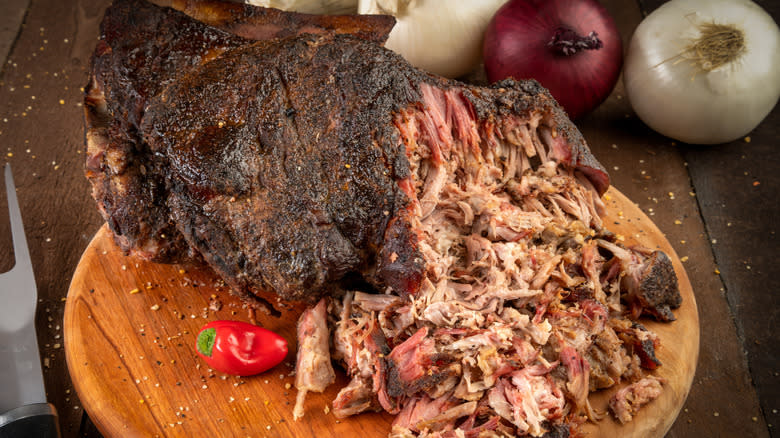
Pork blade steak, also known as pork butt or Boston butt, is a cut of meat that many people are not familiar with. While you may have seen it in the grocery store, because it is not as well known as traditional beef steak or even other cuts of pork, it is often overlooked.
We reached out to two chefs who specialize in cooking steaks and barbecue to get their input into just what pork blade steak is and how to treat it. We spoke to Chef David Rose, a chef, author, and meat expert at Omaha Steaks. He has also competed on "Food Network Star," and now regularly appears on the network, as well as other programs such as "Good Morning America" and "The Today Show." We also spoke to Chef Dylan Ray Lipe, the executive chef at Smoque Steak, a unique steakhouse in Chicago that specializes in smoked steaks. With the help of these two meat experts, we will help you get to the bottom of what exactly pork blade steak is and how to enjoy this wildly underrated cut of meat.
Read more: Cuts Of Steak, Ranked Worst To Best
All About Pork Blade Steak
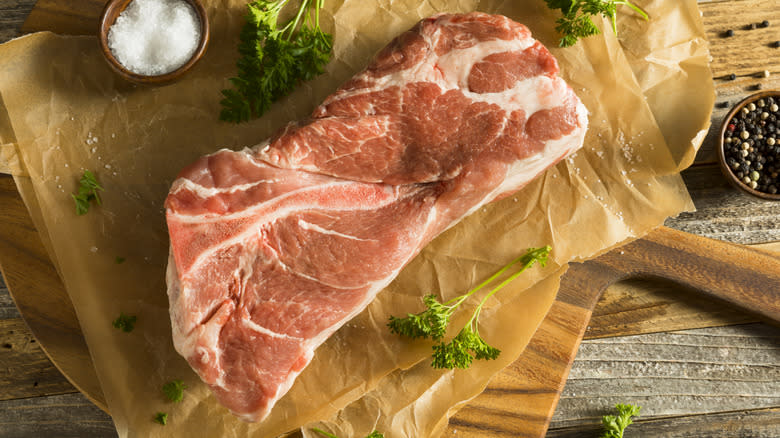
Pork Blade steak is a cut of pork that comes from the shoulder of the pig. According to David Rose, executive chef at Omaha Steaks, the cut of meat originated in the Midwest. Pork Blade steak can also be referred to as Boston butt, pork butt, or pork steak. This cut of meat, according to Chef Dylan Ray Lipe, "is cut from the pork butt roast and typically includes part of the shoulder blade bone." The pork butt comes from the front leg of the pig (this is slightly different from pork shoulder, which is the shoulder of the pig). This cut of meat can come in different varieties; Chef Rose told us that "They can be sliced into thinner steaks ranging from ½-inch to ¾-inch, or thicker steaks ranging from one inch to two inches in thickness." With these different cuts come different recommended cooking methods.
Pork blade steaks are adaptable, difficult to overcook, and overall a great alternative to beef steak. Chef Lipe told us that pork blade steaks "are well-marbled, flavorful, and very adaptable to several cooking methods." Chef Rose let us know that these steaks were created as an alternative to steak so that families could access a similar cut of meat "at a much more affordable price point." He made sure to add, "Plus, they're just delicious!"
How Pork Blade Steak Differs From Beef Steak
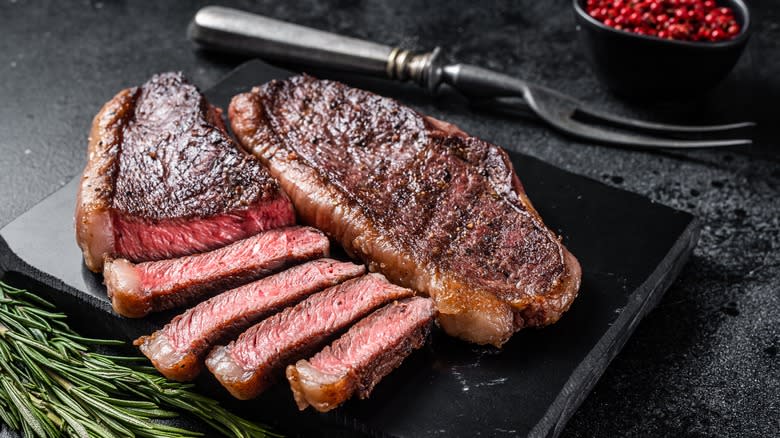
Of course, the most obvious difference between a pork steak and a beef steak is that they come from the meat of different animals. Aside from that, however, there are a few key differences that impact the flavor, texture, and cooking method of pork and beef steaks. When we talked to Chef David Rose of Omaha Steaks about the difference between these two cuts of meat, he told us that pork blade steaks provide a lot more freedom when you are cooking them. He said, "When cooking great quality Omaha Steaks: beef steak product, you have a finite amount of time to zero in on the perfectly cooked steak and your desired cooking doneness." Basically, beef is a lot more finicky when it comes to being cooked because overcooked beef stops being tender.
With pork steak, on the other hand, there is a lot more wiggle room. Chef Rose told us that "You have more flexibility in cooking doneness and they're more difficult to overcook because of all the fat and connective tissue." He is a huge fan of both cuts of meat, however, and told us, "The great thing is that both awesome steaks expand the variety of proteins that can be enjoyed in your kitchen and around your grill all year long!"
Pork Steak Vs. Pork Chops
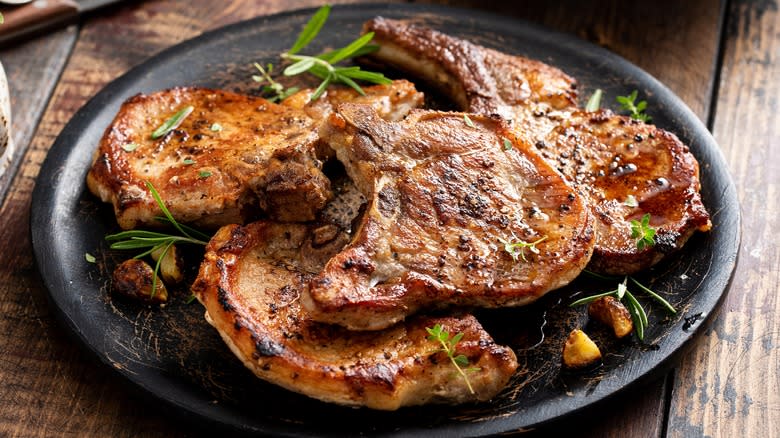
While pork blade steaks come from the upper part of the shoulder of the pig, pork chops come from the pig's loin. The loin is the section of meat that comes from the back of the pig, between its shoulder and hip. Pork chops are far leaner than pork steaks, which means that they may take less time to cook and aren't as juicy. They are, however, very flavorful. Like thinner pork blade steaks, pork chops are well suited to quick-cooking methods and marinades that serve to tenderize the meat. While they are not ideal for grilling, there are ways to grill them correctly.
It is the fat content that is the main difference between these two cuts of meat; it affects the price, the flavor, and the cooking methods. Pork steaks tend to be darker in color, making them easy to tell apart from pork chops. They also have a higher fat content, often with visible marbling. Pork steak tends to be more affordable than pork chops, also due to the difference in fat content. Because the fat needs to be rendered out and the connective tissues need to break down, it takes much longer to cook pork steak than to cook pork chops. The result, however, is an extremely flavorful, tender piece of meat.
Try Preparing Your Pork Blade Steak In A Smoker
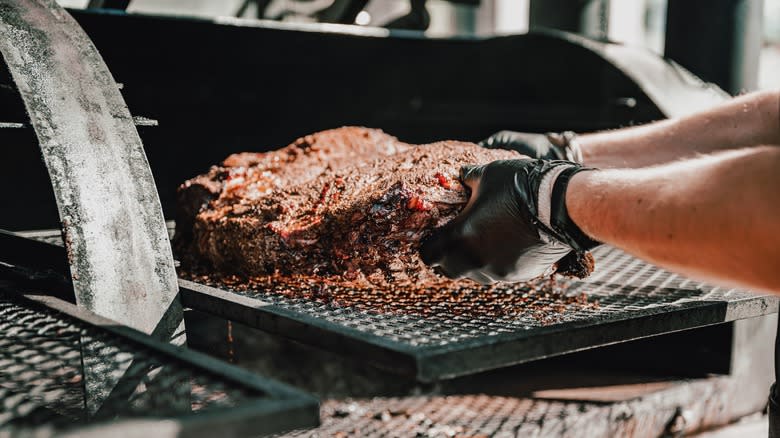
Chef David Rose told us, "Since the pork steak is cut from the pork shoulder, and a pork shoulder's best friend is the grill/smoker, the best way in my opinion to cook the pork blade steak is on the grill." This is because there is a lot of fat and connective tissue marbled throughout the steak. Chef Rose said, "You want to make sure you render the fat and break down the connective tissue."
Chef Lipe, who also prefers to cook his pork steak in the smoker, explained to us his method for smoking the meat. He told us that he starts with a one-inch thick cut of steak. Then, he told us, "I season the pork steak on both sides with my favorite BBQ rub and dry brine in the refrigerator for an hour." When the steak is ready to be cooked, he places it on a smoker at 250 degrees Fahrenheit for an hour "until it has a nice mahogany color." Then he will re-season his steak, add butter and honey, wrap it in foil, and return it to the smoker, where he lets it sit for another hour ("until it reaches 180-185 degrees Fahrenheit and feels tender"). Then, he told us, "I remove it from the smoker and open the foil to vent. Once slightly cool, I place the pork steak on a hot grill." He will baste the meat with barbecue sauce several times.
If You Don't Have A Smoker, Use Your Grill
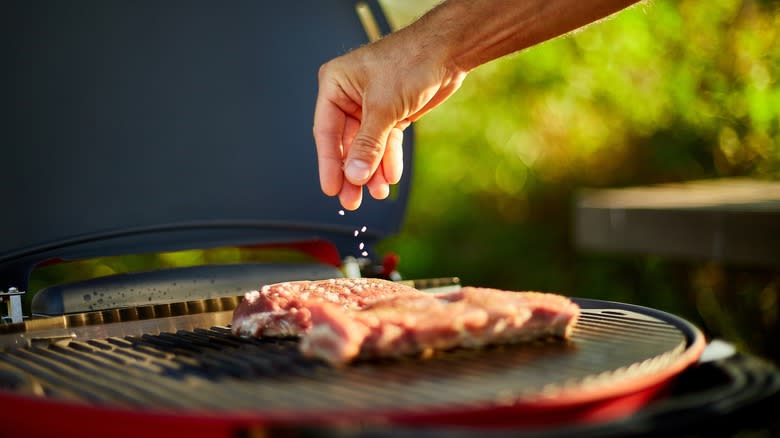
Chef Rose, on the other hand, gave us his method for cooking thinner pork blade steaks on the grill. The thinner the steak, the less cooking time it needs; not only because there is less meat to cook through, but also because there is less fat and connective tissue that needs to break down. Chef Rose told us, "For thinner pork steaks, you can do high and fast on the grill. 550 to 600 degrees [Fahrenheit] on the grill is best!"
He told us that he grills his pork steaks for five to six minutes on each side "until [the] internal temperature is 155 to 160" degrees Fahrenheit. This length of cooking time will "give these steaks adequate time to cook down the fat, and crisp up." While this method of cooking allows for the steaks to be seasoned or marinated beforehand, it does mean that slathering or basting them in barbecue sauce is not necessarily recommended. Chef Lipe told us that it is important that your grill isn't too hot when you add barbecue sauce because you will burn the sugars in the sauce.
If You Don't Have A Grill, Use Your Oven
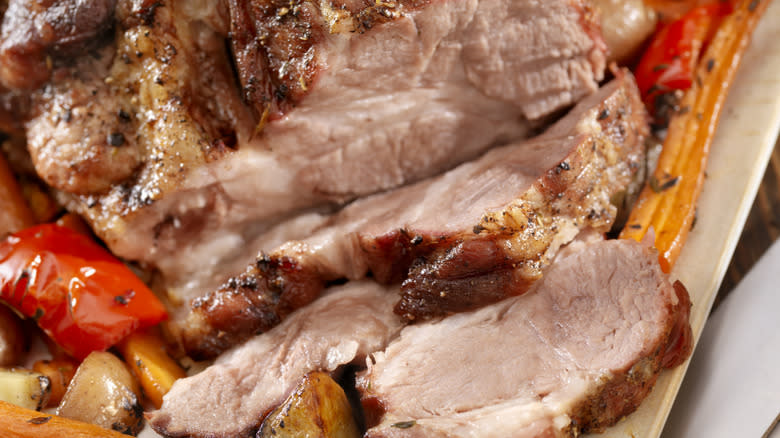
While you can cook your pork steak in many ways, such as in a slow cooker, Chef Lipe has a favorite way of preparing the cut. The chef told us that the best way to prepare pork blade steak at home if you don't have a grill or a smoker is to follow a similar cooking method but use your oven to smoke the meat instead of a grill. He told us that he prefers this method to cooking the meat "hot and fast" on the grill because his smoking method "delivers a pork steak that is the best representation of all its virtues: rich, tender, meaty, and flavorful."
Talking about his method for smoking pork blade steak, Chef Lipe explained in detail how he bastes the meat with barbecue sauce to maximize flavor and tenderness. The chef told us that he pours "about ¼ cup of BBQ sauce in the foil wrap with the juices from the cook and use[s] a basting brush to mix fully." This is the mixture with which he bastes the meat, repeating the basting process a couple of times before taking the meat off the heat, whether that be a smoker or the oven.
The Best Seasonings To Use With Pork Blade Steak
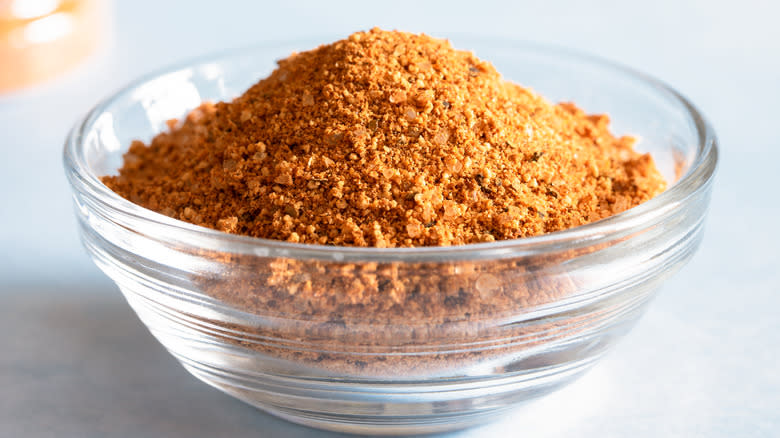
Both Chef Rose and Chef Lipe agree that the best flavoring for pork steak is barbecue. The two chefs use traditional seasonings found in barbecue dishes. Chef Rose told us, "I love using the same seasonings I use on a pork shoulder on my pork steaks, since they always play well with BBQ: Kosher salt, black pepper, granulated garlic, granulated onion, cumin, cayenne, paprika, mustard, brown sugar, etc." Chef Lipe told us he loves "salt, pepper, garlic, onion, brown sugar, paprika, various chili powders, and cumin."
Chef Rose clarified that "anything you would use when you make BBQ or pulled pork would be a great addition to pork blade steaks." The chef treats pork blade steak like he would treat any other barbecue. He cooks his steak on the grill "until they reach between 160 and 170" degrees Fahrenheit, then he wraps them in parchment with barbecue sauce, apple cider vinegar, and some honey, and continues to cook the steaks until they are done. He knows that they are done when they reach between 200 and 205 degrees Fahrenheit; he told us, "At this point they're super tender, the fat has rendered down and the connective tissue is soft."
For Thinner Steaks, Try A Citrusy Marinade
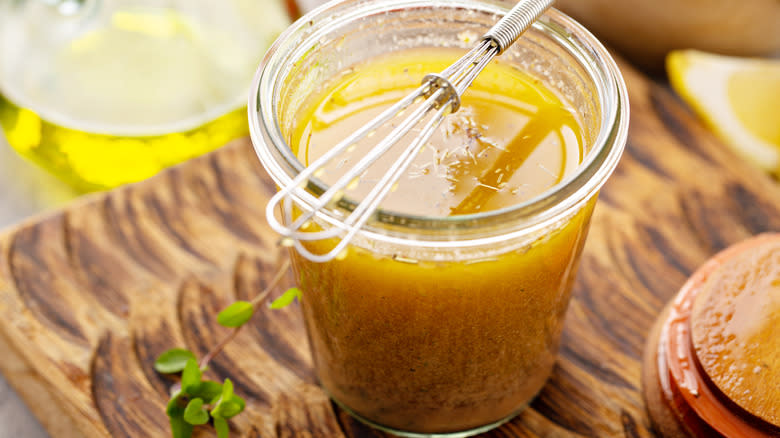
Because Chef David Rose recommended that you cook your thinner pork blade steaks quickly and on a hot grill, he gave some options for tenderizing your piece of meat. The chef recommended starting with a marinade, saying, "A nice marinade with citrus, fresh herbs, aromatics, olive oil, and/or vinegar, can tenderize these thinner steaks even more, if desired." The reason that Chef Rose recommends ingredients like citrus and vinegar is because the acids in these ingredients play an important role in tenderizing the meat.
Ingredients like citrus are great for tenderizing meat because the acid in them "denatures," or unwinds, the long strands of protein in the muscle. Other ingredients that serve to tenderize meats are fruits that are a good source of enzymes, which also break down proteins, such as pineapple. The same is true of yogurt, which has acids and enzymes alike. This is why dry rubs tend to be better when slow-cooking meat, as the cooking process itself will make the meat tender, while if you are cooking meat more quickly, marinades can be a great option.
Pork Steak Is An Economical Option
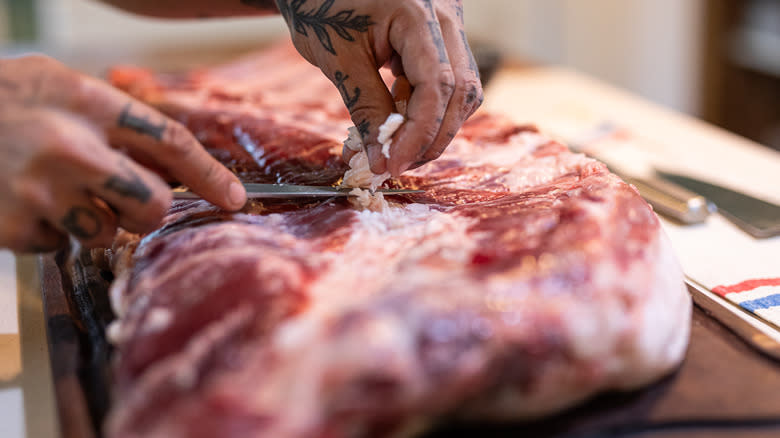
Chef Lipe shares with us that where he was raised, pork blade steak is a popular option for events because of how affordable it is. He told us that "Pork steak is a very hearty yet cheap cut to serve. Where I was raised it was often served at banquets, weddings, and gatherings that required a more formal approach but still needed to be economical."
Part of this is because the cooking method allows one cut of meat to be prepared for a large number of people. With beef steak, each steak must be cooked to the preferred doneness of the guest in question, especially at events like banquets and weddings, as mentioned by Chef Lipe. At the same time, cooking an individual steak for what may be several hundred people is an extremely expensive option and one that many people cannot afford, especially if you want a nice cut of meat. Chef Lipe said that in addition to eliminating the hassle of preparing dozens, if not hundreds, of individual steaks, "Because of its muscle fiber and marbleization, it makes cooking and holding it increasingly easier than beef." On top of that, Chef Lipe told us, "It offers a blank slate for flavors."
Read the original article on Mashed

